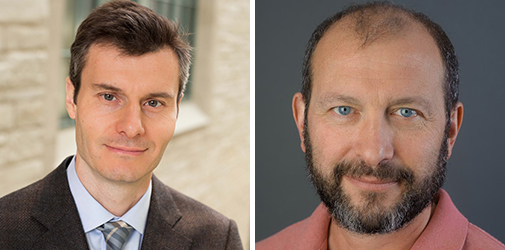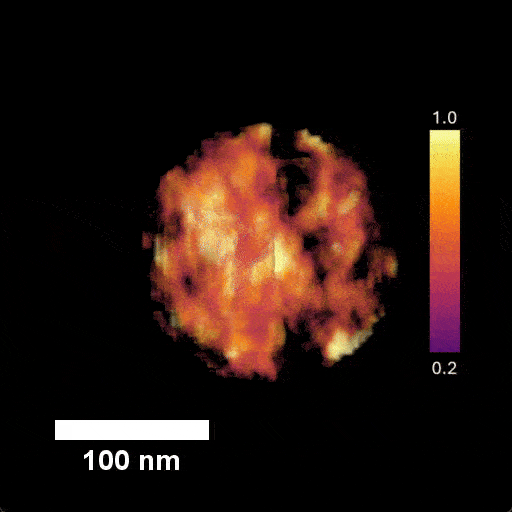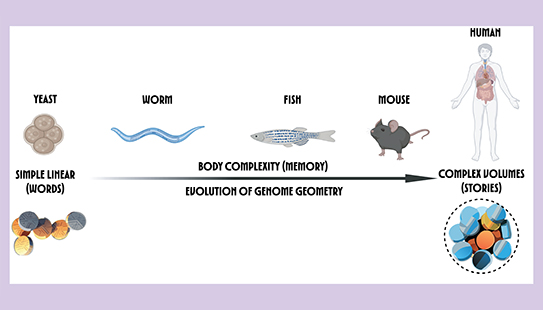The Problem
Decades of research has viewed DNA as a sequence-based instruction manual; yet every cell in the body shares the same genes – so where is the language that writes the memory of cell identities?
Decades of research has viewed DNA as a sequence-based instruction manual; yet every cell in the body shares the same genes – so where is the language that writes the memory of cell identities?
Researchers discovered a new language hidden in the genome beyond the DNA sequence. The geometric code may help cells “remember” how to create and preserve memories, functioning instead like a network of living computers whose operations are encoded in the nanoscale shape of the genome.
Understanding and harnessing this new geometric language of the genome could transform the ability to restore lost cellular memories during aging, erase harmful memories driving chronic disease, and possibly even unlock the rules that gave rise to complex life.
Professor Vadim Backman; Professor Igal Szleifer; Luay Almassalha, Department of Gastroenterology and Hepatology, Feinberg School of Medicine; Kyle MacQuarrie, professor of pediatric oncology, Feinberg School of Medicine

New research reveals the second language of the human genome – one not written in its chemical letters but in its physical shape.
Scientists have long thought of DNA as an instruction manual written in the four- chemical bases—A, C, T, and G—that make up the genetic code. The prevailing belief was that by decoding these sequences, we could unlock how cells and organisms fundamentally work. Now, research from Northwestern Engineering’s Vadim Backman reveals a second “language” of life: the “geometric code” embedded in the genome’s physical shape. Like a blueprint for making living microprocessors, the geometric code helps cells store and process information.

“Rather than a predetermined script based on fixed genetic instruction sets, we humans are living, breathing computational systems that have been evolving in complexity and power for millions of years,” Backman said.
Backman is the Sachs Family Professor of Biomedical Engineering and Medicine at Northwestern’s McCormick School of Engineering, where he directs the Center for Physical Genomics and Engineering. He also is an associate director of the Robert H. Lurie Comprehensive Cancer Center at Northwestern University.
The study, led by Backman in collaboration with Igal Szleifer, Christina Enroth-Cugell Professor of Biomedical Engineering at the McCormick School of Engineering; Luay Almassalha, of the Department of Gastroenterology and Hepatology within the Feinberg School of Medicine; and Kyle MacQuarrie, assistant professor of pediatrics within the department of hematology, oncology, and stem cell transplantation at Feinberg, titled “Geometrically Encoded Positioning of Introns, Intergenic Segments, and Exons in the Human Genome,” published Oct. 27 in Advanced Science, decodes this language, showing how cells can perform computations through the physical shape of their genomes.
Vadim BackmanSachs Family Professor of Biomedical Engineering and Medicine
The geometric code is the blueprint for how DNA forms nanoscale packing domains that create physical "memory nodes" — functional units that store and stabilize transcriptional states. In essence, it allows the genome to operate as a living computational system, adapting gene usage based on cellular history. These memory nodes are not random; geometry appears to have been selected over millions of years to optimize enzyme access, embedding biological computation directly into physical structure.
 “We are learning to read and write the language of cellular memories. These ‘memory nodes’ are living physical objects resembling microprocessors. They have precise rules based on their physical, chemical, and biological properties that encode cell behavior,” Szleifer said.
“We are learning to read and write the language of cellular memories. These ‘memory nodes’ are living physical objects resembling microprocessors. They have precise rules based on their physical, chemical, and biological properties that encode cell behavior,” Szleifer said.
The study suggests that the geometric code may have been a key adaptation that accelerated the evolution of complex body plans. During the Cambrian expansion, genome geometry could have enabled a rapid increase in cell types — not by inventing new genes, but by creating new ways of writing with them. This may help explain how cells maintain identity while still adapting to new environments: memory nodes link genetic information to physical structure, allowing new genome ‘stories’ to be written without changing the underlying DNA sequence.
Backman proposes that the combination of geometric cellular memory and gene mutations may have created a self-learning system.
“Looking across time,” Backman said, “life progressed rapidly from single-celled organisms into bodies with brains. This allowed, for example, building human societies that can overcome unbelievable challenges like inventing spaceflight and AI. And when we look closely, the rules of AI mirror the computational rules underlying genome geometry.”


Reflecting on the technological leap that made this discovery possible, MacQuarrie noted: “We’ve spent 70 years learning to read the genetic code. Understanding this new geometric code became possible only through recent advances in globally-unique imaging, modeling, and computational science—developed right here at Northwestern.”
The questions that arise from the study are virtually endless—how will we continue to evolve? What could be possible if we learn to harness the computational powers of genome geometry and genetics? And what does this tell us about our past, our present, and our future?
Imagine evolution not as adding more words to a dictionary but learning to write stories with them — progressing from vocabulary into songs, from sequence to language. What comes next really invites the imagination.
“While the genetic code is much like the words in a dictionary, the newly discovered ‘geometric code’ turns words into a living language that all our cells speak.” Almassalha said. “Pairing the words (genetic code) and the language (geometric code) may enable the ability to finally read and write cellular memory.”
“Imagine evolution not as adding more words to a dictionary but learning to write stories with them — progressing from vocabulary into songs, from sequence to language,” Szleifer said. “What comes next really invites the imagination.”
Backman and his team are looking forward to realizing the potential of these breakthroughs as they pursue more answers.
“Instead of a puzzle of genetic words, the geometric code lets cells build elaborate tissues, such as brains or skin,” Almassalha said. “But with age, this language loses its fidelity. This decay results in neurodegeneration, cancer, or other diseases of aging.”
“The next step is to fully learn the engineering principles of the geometric code so we can repair dysregulated cell memories or create entirely new ones,” Backman said. “Current approaches to aging try to reset cells back to a factory default state. The geometric code works differently. Cell memories are physical structures enhanced by experience. Revitalizing cells resembles restoring the clarity of a well-loved book — bringing back the stories our cells already know how to tell.”